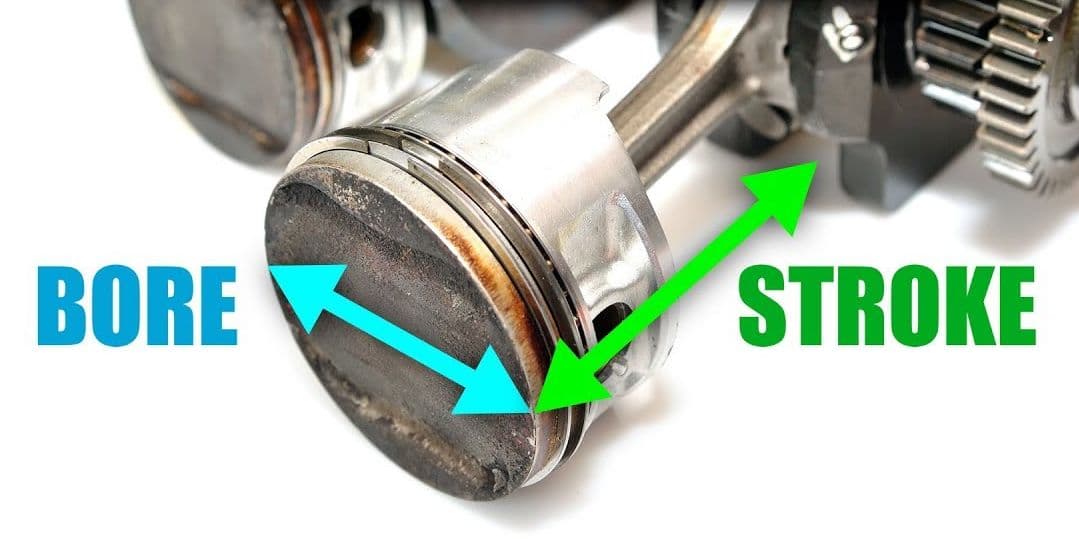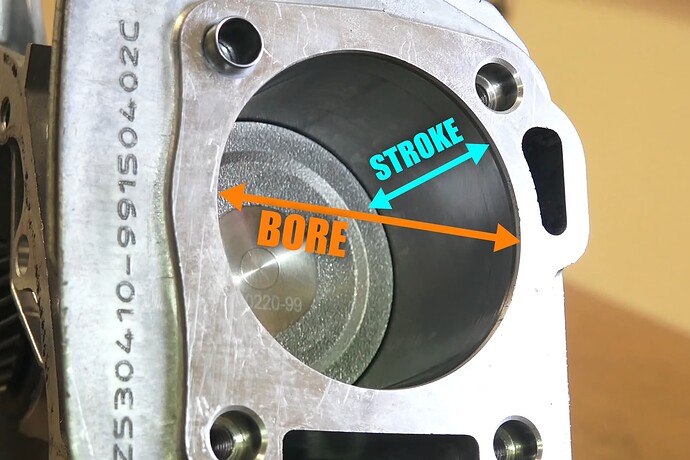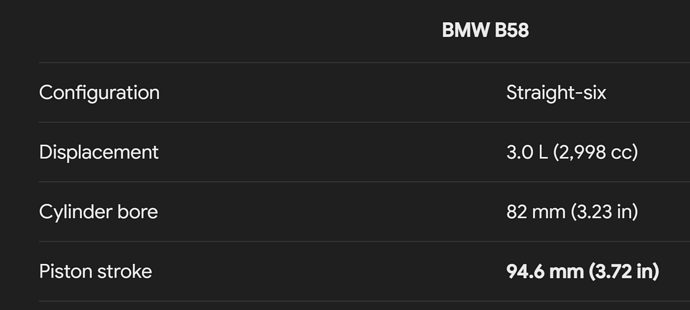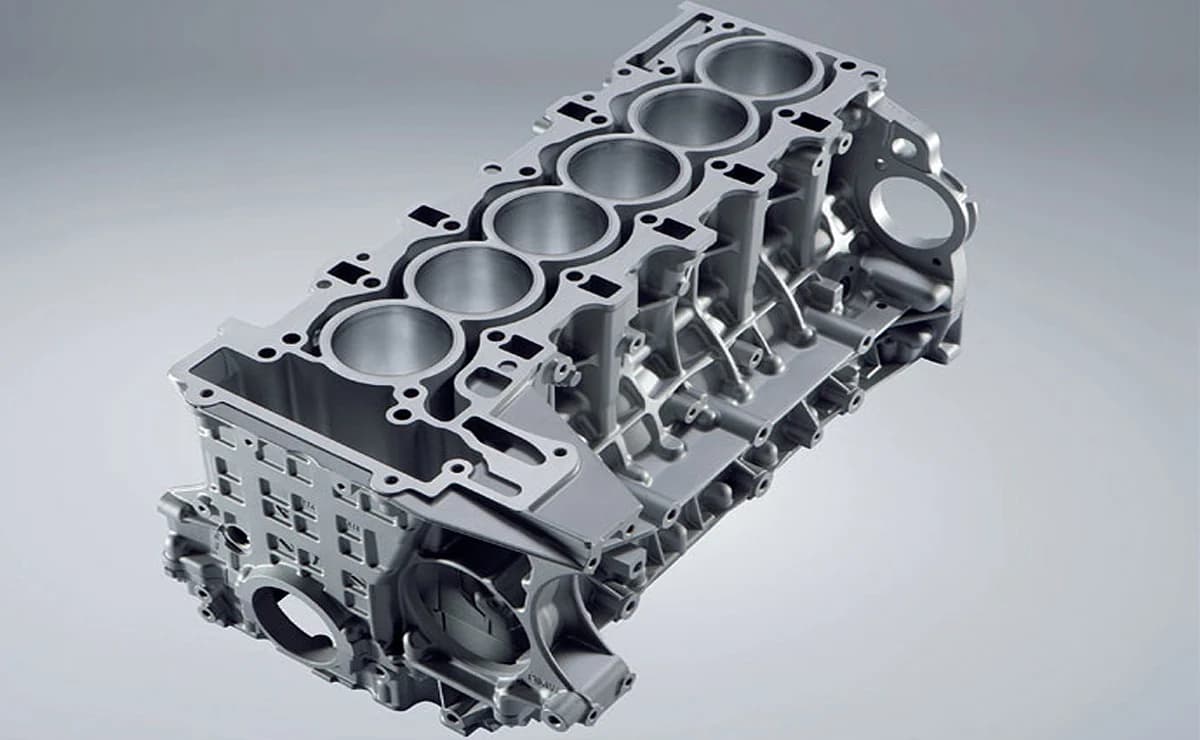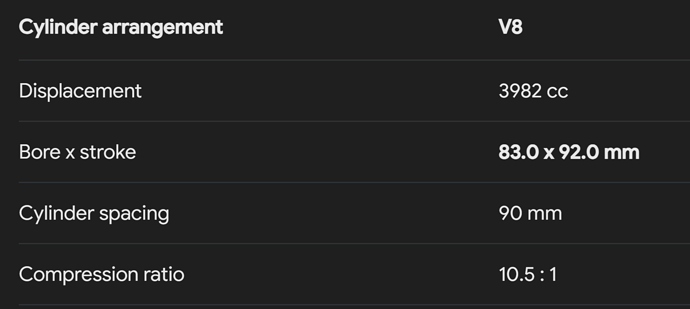when comparing Porsche 911 to AMG GT ( roadster ) in another thread i observed that even though one is a 6 cylinder and another is 8 cylinder they are directly comparable because of similar PISTON AREA ( they also have similar engine displacement as well, but that is less important ).
so what is Piston Area and why is it more important than displacement ?
well mathematically piston area is proportional to BORE squared times the number of cylinders. this is as opposed to displacement which is proportional to the product of Bore, Stroke and Number of cylinders …
as you can see from images above the “bore” is the diameter of the cylinder while the “stroke” is how far the piston goes back and forth.
frankly the stroke is almost completely irrelevant for any purpose and the only reason engine displacement is even a useful metric is because in 90% of engines bore and stroke are close to being the same ( known as "perfectly square " ), in this case the product of bore and stroke is basically the same as bore squared.
actually in most engines the stroke is slightly longer, by about 10% but the important thing is that because the ratio of bore to stroke is fairly similar in most passenger cars it makes displacement ( product of bore and stroke ) relevant even though only the bore is actually relevant and not stroke.
but that is only true of NORMAL engines, like the ones you would find in a Toyota Camry … it is NOT true of engines designed for extreme performance such as what you find in Formula 1, Superbikes or the higher-end Porsche 911 models …
when performance is key what you will often see is bore getting larger independently of stroke … this is known as “oversquare” … the most extreme oversquare engines i know are Formula 1 ( 80 mm bore / 50 mm stroke ) and Ducati V2 ( 100 mm bore / 60 mm stroke ) engines … which is more than 1.5 X ratio of bore to stroke … the 911 GT2 RS at 102 mm / 77 mm and a ratio of 1.3 is up there as well …
if you think about it Porsche GT3 engine is basically three Ducati V2 engines …
by contrast in the past ( like 100 years ago ) engines used to be very “undersquare” with large displacements ( like 8 liters ) and low power outputs ( like 50 horsepower ) …
the reason stroke is irrelevant is because power is not a function of stroke or RPM but PISTON SPEED which is proportional to product of stroke and RPM and while both stroke and rpm vary among engines PISTON SPEED that is realistically attainable is more or less fixed due to the fact that speed of sound is a constant …
essentially because the cross section of intake valves is proportional to piston area and air speed in intake valves is limited by speed of sound that places a limit on piston speed regardless of stroke and RPM …
when stroke goes up maximum RPM goes down and vice versa such that piston speed ultimately stays the same …
obviously in extreme applications like Formula 1 piston speed will push closer to limit than in reliability oriented applications like diesel locomotives but they’re closer together than you would imagine considering F1 revs to 15,000 rpm and diesel locomotive to 1,500 rpm. and that’s because F1 stroke is 2 inches whereas diesel locomotive stroke is 10 inches so even though F1 has 10 times higher RPM it only has 2X higher piston speed.
the other limiting factor for piston speed is lubrication. higher piston speeds mean poor lubrication and high engine wear. of course F1 engines only need to last a few races, whereas locomotive engines last a million miles and that is why you see lower piston speed there, but again, i want to stress how relatively small the difference is because for most intents and purposes piston speed is a constant.
power is basically a product of piston area, piston speed and air charge pressure ( atmospheric pressure plus any turbo boost ) … but piston speed is mostly fixed and turbo boost pressure is also relatively fixed if you want good efficiency and low turbo lag ( this limitation is relaxed with electric turbos that reduce lag and improve efficiency ) which means it basically comes down to piston area as what really drives performance …
the reason power is a product of piston area, piston speed and air charge pressure is because that is what determines the rate at which the engine breathes air, and because fuel-air mixture ratio is also a constant the rate at which fuel can be injected and burned and because thermal efficiency is also constant at about 40% the rate at which energy can be produced, which is called power.
with this understanding you can do a quick google such as “BMW b58 bore stroke” and get:
then you can google “porsche gt2 rs bore stroke” and get:
so you see despite having much larger displacement per cylinder the stroke on GT2 RS is actually shorter ( 77 mm vs 94 mm ) than on BMW while the Bore is MUCH larger ( 102 mm vs 82 mm )
(102/82)^2 = 1.54 so Porsche has 54% more piston area per cylinder and since both engines are 6 cylinder also 54% more overall piston area.
not surprisingly the Porsche GT2 RS engine also makes about 50% more power than BMW 3.0 Turbo engine …
also note that 94/77 = 22% longer stroke in BMW which means BMW will need to have lower redline than Porsche and indeed it does, though the difference isn’t that great - 6,500 rpm for BMW and 7,000 for GT2 RS …
if you only looked at displacement you would be surprised that much larger porsche engine revs higher than the smaller BMW engine but if you understand RPM is a function of stroke and not displacement then actually Porsche engine could have revved higher but because of turbocharging ( and resulting mid range torque ) it is not actually necessary …
bottom line it isn’t that BMW are idiots and Porsche are geniuses and that’s why Porsche 6 cylinder makes 200 more HP than BMW 6 cylinder but a simple matter of geometry. BMW used a small bore because they wanted to keep the inline-6 engine short enough to fit under M3 hood
… and Porsche used a short stroke because they wanted to keep the boxer engine narrow enough to fit in the back of the 911 …
and large bore because they had to compete with V8 powered competitors like AMG, and they and for that they had to match or over-match the piston area with fewer cylinders to do it, thus larger bore …
so for example AMG GT bore and stroke
(102/83)^2 = 1.5
911 GT2 rs has 50% more piston area per cylinder but AMG has 8/6 = 33% more cylinders so overall GT2 RS has 1.5/1.33 = 13% more piston area than AMG GT V8.
what about power ? 690 hp / 600 hp = 15% more power for GT2 RS.
so 13% more piston area and 15% more power for GT2 RS versus AMG GT.
all checks out.
